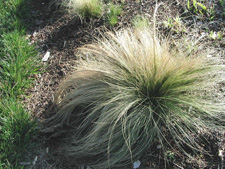Resource Library
Plant of the Week: Mexican Feather Grass
The University of Arkansas System Division of Agriculture does not promote, support or recommend plants featured in "Plant of the Week." Please consult your local Extension office for plants suitable for your region.
Plant of the Week
Mexican Feather Grass
Latin: Nassella tenuissima

As ornamental grasses have become mainstream in our gardens, the best have been identified, some have been dropped, while others have been added to fill specific niches in garden design.
One of these new grasses is Mexican feather grass, a low-growing, graceful mound of a plant well suited for low maintenance gardening.
Mexican feather grass (Nassella tenuissima) is a 1- to 2-foot tall perennial bunch grass that grows like a cascading fountain. The wiry, slender, hair-like leaves are green and silky in the spring and buff colored during the winter. In spring, it has a more erect habit as the slender, silvery, nodding panicles push above the foliage. In dry sites, it may go dormant in summer and begin growing again when temperatures cool and rains return in the fall.
It’s native to parts of west Texas, New Mexico and the north-central states of Mexico where it grows in open, dry woods, on rocky slopes and dry, disturbed areas.
Mexican feather grass hit the garden mainstream in the mid-1990s and has proven much more widely adapted than previously thought.
This grass highlights one of the quandaries gardeners face when deciding what to grow. It’s one of the good guys in the landscape because it’s easy to grow, drought tolerant, good for xeriscape plantings and pest free. It’s a real low-maintenance gem, and it can reseed.
Because it’s native to a neighboring state, you might even consider it a native plant. We freely consider plants of the eastern deciduous forest as "natives" though not originally found on our side of the Mississippi River. So, should a plant to the drier regions to our west be any less native?
I don’t think Mexican feather grass will jump from being a garden ornamental to a weed in most areas of the eastern United States. It will not survive close mowing and frequent
watering in the typical lawn and is too shade intolerant to survive long in shaded beds and borders. It could move into waste places along roadsides where it would have to slug it out with the other weeds - most of which were introduced long ago. It’s not an aggressive enough grower in the seedling stage to compete with established pasture grasses.
If Nasella is going to escape into the wild it will most likely do so in a climate similar to where it originated. Naturalized stands have been reported in New Zealand, South Africa, California and parts of Australia where it slipped through under the obsolete Latin name of "Stipa".
In the garden, Mexican feather grass is best used in masses as an open, airy groundcover, for edging beds or to cover steep banks. It has a landscape look similar to that of weeping love grass often used along highway roadcuts. It fits well in natural landscape plantings, rock gardens and in conventional borders where the fine texture plays off of the coarser texture of neighboring plants.
It does best in full sun in a well drained soil. It can be grown from seed or new plants can be propagated by springtime division of the clumps. Because the old foliage persists into the new season, shearing plants back in late winter before new growth begins gives a tidier look. If reseeding is a concern, delay the shearing operation until after the flower scapes have emerged.
By: Gerald Klingaman, retired
Extension Horticulturist - Ornamentals
Extension News - March 23, 2007
The University of Arkansas System Division of Agriculture does not maintain lists of retail outlets where these plants can be purchased. Please check your local nursery or other retail outlets to ask about the availability of these plants for your growing area.